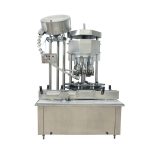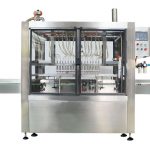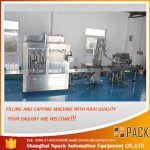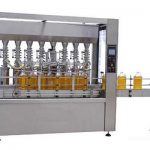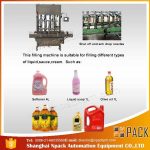
NP-S semi automatic oil filling machine which We adopted advanced techniques and designed the NP-S series. Our products are handy in operation, precision adjustment, volume adjustment, maintenance repairs and so on.
We substitute pneumatic components for electricity control circuit in the NP-S series piston fillers, so it is especially suitable for explosion-proof.
1. Selection of types
We classify the types of NP-S semi automatic oil filling machine by the maximum filling volumes which most customers require.
NP-S are divided into 6 basic types as follows:
NP-S-3 (15~30ml)
NP-S-6 (15~60ml)
NP-S-12 (30~120ml)
NP-S-25 (60~250ml)
NP-S-50 (120~500ml)
NP-S-100 (250~1000ml)
NP-S-500 (500-5000ml)
2. Working principle
The working principle of our NP-S is explained as follows: the cylinder’s moving back and forth makes the piston reciprocate, thus, negative pressure is created in the front of the material tank.
The cylinder draws the piston back when it moves back, which makes negative pressure in the front of the material tank. Then material inside the reservoir is atmospherically pumped into the material tank via an intake soft pipe and a three-way pipe.
The cylinder draws the piston forth when it reverses. Meanwhile, the one-way valve opens, permitting squeezed material escaping from the material tank through outlet soft pipe to a nozzle, and then the nozzle dispenses material into bottles. The filling nozzle is closed when sucking out material, and verse vice. In this way, once filling is finished.
Our NP-S has high precision and stability to every regular container, because each filling is a unitary and mechanical motion.
3. Features of NP-S
1) NP-S semi automatic oil filling machine is controlled with compressive air, so it is specially suitable for explosion-proof.
2) Static electricity and electric shock will not occur. And grounding is unnecessary.
3) Because of using pneumatic control and force position, it has high filling accuracy, which is within 3/1000 (Based on the maximum filling volume).
4) If it needs crash-stop, you can only turn off the pneumatic switch. The piston draw back to the initial position and then filling will be stopped.
4. Checks before starting machine and sequence of operation
It is necessary to check the machine before starting. If mechanical and electrical parts are abnormal, the machine will break down or injury accident will be caused.
The content of checks and operations is as follows:
1) Be sure the front and the back handle are tightened.
2) Make sure that clamps located at each end of the three-way are tightened.
3) Confirm that the two cross fixtures employed to fix the horizontal beam, the vertical beam and the nozzle are secured tightly.
4) Switch on the air pressure supply, the pressure is less than 8kg/cm2
5) Turn on the air supply.
(Notes: Long-time working without material is strictly prohibited.)
5. Adjustment of filling volume
The filling volume depends on the capacity (ml) or weight (g) that the user wants. Because the specific gravity of material ranges greatly, the same data on the survey meter may be not applicable for all materials. The distance control switch can be accommodated to obtain an exact data.
Detailed operations are as follows:
1) Rough adjustment: Move the adjustment screw left and right in order to regulate of advancement air control switch. Adjust the screw of backhaul air control switch properly to reach the satisfied position.
2) Place a measuring cup or a stuff bottle below the nozzle. (Notes: a full material tank ensures high accuracy and vice versa.) Put the cup or bottle onto an electronic balance to check out whether the filling volume is accurate.
3) If error still exists, it is essential to regulate the backhaul distance control switch through the handwheel. Filling volume increases when the adjuster slides left, and vice versa.
4) Adjust repeatedly until it reaches the proper filling volume and precision.
6. Adjustment of filling velocity
Filling velocity is decided by following 5 factors:
1) Velocity of material and length of intake pipe
2) Dimension of the nozzle. The larger the nozzle is, the faster filling will be.
3) The extent of foaming. You’d better slow down the velocity when filling foamy material.
4) How much to fill. Please fill at a low speed if the filling volume is large.
5) Filling precision. If you demand a high accuracy, filling velocity should be decelerated.
Tips for adjusting operation:
1) Loosen the adjustable nuts which fix the front and back speed control valve.
2) Turn the handle of the front one-way throttle valve clockwise, filling velocity slows down when the cylinder’s advance decelerates.
3) Turn the handle of the front one-way throttle valve anticlockwise, filling velocity speeds up as the cylinder’s advance accelerates.
4) Turn the handle of the back one-way throttle valve clockwise, inhaling speed decreases as the cylinder’s countermarch
7. Adjustment of filling precision
Filling error is mainly determined by filling volume, filling velocity, on-off frequency of the up valve and the down one. The on-off frequency is relative to the material viscosity. The more viscous material is, the lower on-off frequency is.
Modifying spring force can adjust the on-off frequency. If the spring force is increased, this frequency will be boosted.
You can get an appropriate spring force by measuring filling volume or with operator’s experience.
8. Maintenance and repairs
Before washing this machine, you’d better clean up all materials left inside it, afterwards fill moderate scour into the reservoir. We suggest you to use warm water. Surely, if necessary, suds, alcohol and other scour are available.
Make certain that all seals are at their working positions while washing. Keep this machine continuously running until it has been cleaned up. This simple manner is recommended if your demand is not strict. Or it is sure to thoroughly wash up all the parts contacting with the material, including cylinder, piston, seals, nozzle, hopper and so on. Firm that none seal is missed. Then change the broken and the worn-out seals.

